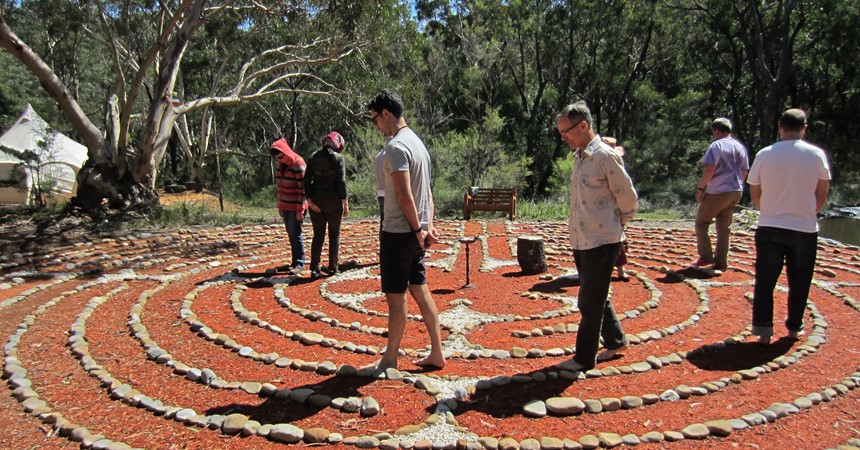As an enthusiastic pilgrim I often encourage others, especially those who find themselves in a rut, to embark on their own pilgrimage. But I find myself saddened by a common response: “Oh, I would love to, but I can’t afford to travel to France or Spain – the Camino is just so far away…”.
In my experience, pilgrimage can be undertaken anywhere, any day – often costing nothing at all! Being a pilgrim is a state of mind, an attitude to life, and it’s one we can adopt everyday as we journey through life.
It certainly encompasses overseas travel and trekking long distances, but it can also mean heading to the nearest bushwalk, public labyrinth, and – I would suggest – it can be done without leaving your lounge-room chair.
Pilgrimage is a journey to Santiago, the Overland Track, Centennial Park Labyrinth, or to the most sacred of places, the human heart.
The concept of pilgrimage was foreign to me until my late 20s. As a busy Gen X-er I’d focused on productivity and efficiency – rather than taking time for wandering and spiritual pursuits. But when I discovered a contemplative spirituality, which happened when my busy backpacking trip in Ireland transformed beautifully and unwittingly into a pilgrimage, many things shifted for me, including how I saw myself and my life.
I imagined my future as no longer ticking off goals on a list as I tried to climb the ladder, but as a gently-paced journey; of learning, discovery, seeking wisdom. The path loosened, from a linear line, to a spiral. In the space of a month I had gone from a mindset of ‘professional’ to ‘pilgrim’.
Direct from Ireland, I embarked on my first pilgrimage to Assisi, having just discovered, and been inspired by, the life of St Francis. A few years later, seeking more meaning in my day-to-day life I saved up, bought a backpack, and left behind my job in politics – as well as my future as I had always envisaged it. I printed business cards which read: Donna Mulhearn: Pilgrim & Storyteller.
I made a rough plan, but really had no idea where I would be in a few years time. The future was unsure, but I felt exhilarated. The gospel phrase “when you lose your life, (for my sake) you find it” was playing out in wonderful ways as I travelled as a pilgrim to Uluru, then to wilderness in Alaska, lakes and glaciers in Canada, mountain tops and monasteries in Tibet – armed with a journal, prayer beads, spiritual texts and my daily practice of Christian meditation.
It was an exciting outward journey – but of course, a more exciting inner one. That’s what makes pilgrimage different from tourism: the intention to do inner work, often using ritual to imbue deeper meaning into what would otherwise be everyday travel experiences. A pilgrim travels through the world paying attention, with a sense of presence to the moment, thus making each moment sacred. And on pilgrimage we don’t just meet new people; we meet ourselves in a new way.
I try to maintain a regular rhythm of pilgrimages to special places, but when I’m not on the road, I find other ways to maintain a pilgrim life. I’m drawn to walk labyrinths, no doubt because of the strong symbolism the labyrinth provides of being on a journey to the centre.
I’ve created three labyrinths at my small retreat centre in the Blue Mountains, so while I can’t head off on a whim to walk the Camino, I can head outside and slowly follow the meandering path to the centre of the labyrinth’s mysterious ancient design. Focused on the path, trusting it, the mind is free to open up to metaphor – the language of the soul.
It’s been observed that labyrinths emerge in the world at times when they are needed; they are flourishing now. In a supposedly secular age, the ancient practice of pilgrimage is also undergoing a revival in these uncertain times.
My daily pilgrimage is to my own centre, my heart, through the practice of Christian meditation, the prayer of the heart. I don’t leave my living room, but I do ritualise the moment with a candle and a reading before entering into the work of the pilgrim, which is the work of presence and paying attention.
It is work, according to the unknown author of the Russian classic, The Way of the Pilgrim, that can be done by anyone. “It costs nothing but the effort to sink down in silence into the depths of one’s heart…”, he writes.
Director of the World Community for Christian Meditation, Father Laurence Freeman, says it is better to think of the journey of meditation as a spiral or a labyrinth, rather than a straight line between two points.
“That is why the mandala is the universal symbol of the spiritual journey,” he says. “At times it may seem as though we are going round and round in circles but in fact we are circling in – ever closer to the centre.”
Living as an everyday pilgrim means being always open to the ancient call, and recognising it could be a call to wander in far-away lands, to journey on a path closer to home, to step onto a labyrinth, or just to sit in the chair in front of you for the pilgrimage within.
Donna Mulhearn is a pilgrim, activist, speaker and manager of Blue Labyrinth Bush Retreat, an eco-retreat in the heart of the Blue Mountains. It offers space for groups and individual pilgrims to gather and explore wisdom teachings and contemplative practices with a focus on silence and meditation, using the Labyrinth as a spiritual tool and sustainability and permaculture as a way of life. This article was first published in The Good Oil, the e-magazine of the Good Samaritan Sisters.























































































